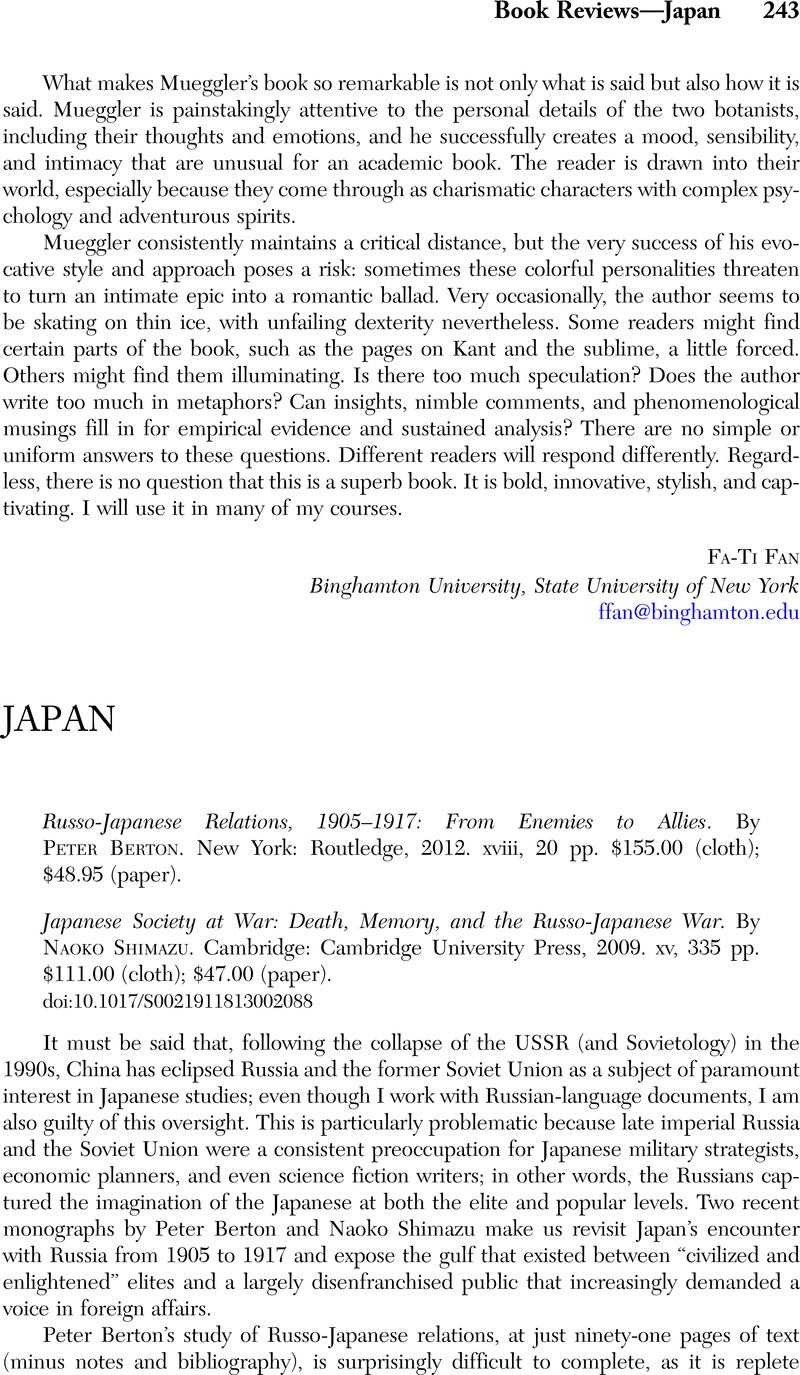No CrossRef data available.
Article contents
Russo-Japanese Relations, 1905–1917: From Enemies to Allies. By Peter Berton. New York: Routledge, 2012. xviii, 20 pp. $155.00 (cloth); $48.95 (paper). - Japanese Society at War: Death, Memory, and the Russo-Japanese War. By Naoko Shimazu. Cambridge: Cambridge University Press, 2009. xv, 335 pp. $111.00 (cloth); $47.00 (paper).
Published online by Cambridge University Press: 27 February 2014
Abstract

- Type
- Book Reviews—Japan
- Information
- Copyright
- Copyright © The Association for Asian Studies, Inc. 2014
References
12 Konishi, Shō, “Re-opening the ‘Opening of Japan’: A Russian-Japanese Revolutionary Encounter and the Vision of Anarchist Progress,” American Historical Review 112, no. 1 (2007): 101–30.CrossRefGoogle Scholar
13 Schiltz, Michael, The Money Doctors from Japan: Finance, Imperialism, and the Building of the Yen Bloc, 1895–1937 (Cambridge, Mass.: Harvard University Asia Center, 2012)CrossRefGoogle Scholar; Smethurst, Richard, From Foot Soldier to Finance Minister: Takahashi Korekiyo, Japan's Keynes (Cambridge, Mass.: Harvard University Asia Center, 2009)Google Scholar; Metzler, Mark, Lever of Empire: The International Gold Standard and the Crisis of Liberalism in Prewar Japan (Berkeley: University of California Press, 2006).CrossRefGoogle Scholar
14 Shinobu, Ōe, Chōheisei [The conscription system] (Tokyo: Iwanami shoten, 1981)Google Scholar; Tadatoshi, Fujii, Kokubō fujinkai [The national defense women's association] (Tokyo: Iwanami shoten, 1985).Google Scholar
15 See especially Tetsuya, Ōhama, Shomin no mita Nisshin / Nichiro sensō: Teikoku he no ayumi [The Sino-Japanese and Russo-Japanese wars as seen by ordinary people] (Tōsui shobō, 2003).Google Scholar
16 Swinton, Elizabeth de Sabato, “Russo-Japanese War Triptychs: Chastising a Powerful Enemy,” in A Hidden Fire: Russian and Japanese Cultural Encounters, 1868–1926, ed. Rimer, J. Thomas (Stanford, Calif.: Stanford University Press, 1995), 114–32.Google Scholar
17 Howes, John F., “Uchimura Kanzō,” and Masamichi Asukai, “Kōtoku Shūsui,” in Pacifism in Japan: The Christian and Socialist Tradition, eds. Bamba, Nobuya and Howes, John F. (Kyoto: Minerva Press, 1978)Google Scholar, 119 and 139.




